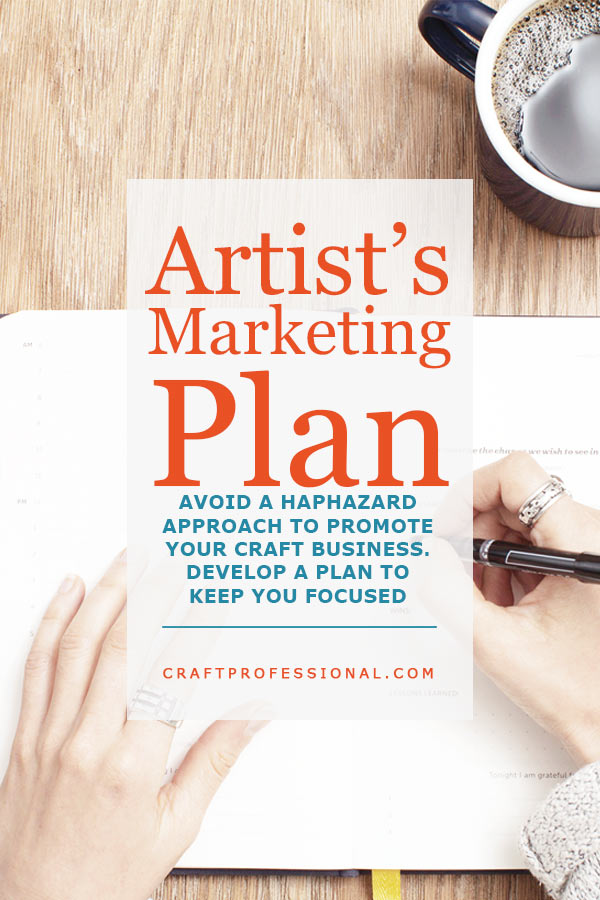Your Artist Marketing Plan
As an artist or craft professional, developing a marketing plan to get the word out about your business will help you stay focused, and accomplish more. Without a plan, you're left jumping at marketing opportunities as the come along without assessing whether they are right for your business. A plan helps you create a smarter, more cohesive marketing strategy, determine your goals, develop a sketch of your target customer, plan how you're going to reach that customer, and build strategies to outshine your competition.
Identify Your Target Market
Get to know your customer. Ask yourself:
- Is your customer typically male or female?
- What is the typical age range of your customer?
- What is their income range?
- What motivates your customer?
- What needs are common to your customers, and how can you meet them?
- What does your customer value in general?
- What do they value about your type of art or craft?
- How do they perceive your type of art?
- Where does your customer live, shop and play?
Getting to know your customer will help you to focus your artist marketing plan and efforts on strategies that appeal to people who are most likely to buy your product.
Determine How You Stand Out From the Competition
Understanding the strengths and weaknesses of your main competitors as well as your own strengths and weaknesses will help you to determine how you will outshine your competition.
For some artists, the first impulse is to compete on price; however, most people buying handmade pieces want something special and unique. As long as it's within their general budget, they are not typically buying based on price, so this strategy is not necessarily effective. A lower price can even backfire by making your work seem less special.
Rather than immediately competing on price, work on developing your own distinct style and voice that is compelling and stands out from the crowd. In addition, research what your customers value. Is it a personal message in the piece, unique function, a meaningful story behind the work? Try to consider those values when creating your work and communicate those benefits to your customers to outshine your competition.
Keep the Big Picture in Mind
It's pretty easy to get bogged down by the daily responsibilities of running a business, but it's important to consistently remind yourself of your long term goals.

Because it can take three to five years for a business to become profitable, it can be easy to get distracted by apparent short term money making strategies. These are strategies that appear to be able to bring you money quickly for the short term, but really don't contribute to the long term growth or direction of your business.
The problem with this approach is that pursuing several unfocused tactics can divide your time and attention so much that you won't be able to focus on any one thing enough to do it well.
Developing a marketing plan will help you establish the company image that you want to portray, understand your customer profile and clarify your long term goals. Once you do that, write them down and post them where you see them. When you are making decisions about whether to pursue specific marketing tactics, refer back to your big picture image and goals and ask whether that strategy serves to meet those ends.
Reconnecting with your big picture will help you to stay on track.
Remember, you're in this business for the long term.
It's easy to become discouraged when marketing efforts don't have immediate results. It takes time to build a reputation, and a customer base. It's important to remember that marketing needs to be ongoing and repetitive. Be sure that you've spent a reasonable amount of time and effort promoting your business before you assess whether you've been successful.
Don't quickly drop a strategy and bounce to something else just because it didn't meet your expectations the first time you tried it.
Build Familiarity
One reason people buy handmade rather than cheaper mass produced goods is because customers want to feel a connection with you, the artist. They understand that your work is special because you made it with your hands and your heart and soul.
The more you can connect with your customers by telling them stories about your work, the more easily your customers will connect with your work. Social media provides brilliant opportunities for you to build this type of connection and familiarity with customers.
Moving Forward
Everything you do impacts a customer's decision to buy.
Everything from the way you speak with your customers, the way you dress when you meet customers, your print materials, your online presence, the way you display and package your work all impact the company image you build in your customers' minds.
Customers quickly and unconsciously link the quality of your marketing materials to the perceived value of your work, so this is not a place to skimp on quality. Similarly, a quick hand written thank you in a package that you mail out to a customer can go a long way to adding to the customer's feeling of personal connection.
Over the course of running your business, you'll make plenty of decisions. Some will seem monumental and some will seem meaningless. All of them should be considered part of your artist marketing plan because they will all subtly or substantially impact your company's image in the customer's mind.


New! Comments
Have your say about what you just read! Leave me a comment in the box below.